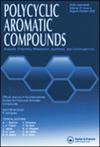Synthesis, Computational, Antimicrobial, Antioxidant, and ADME Study of 2-(3,4-Dimethoxyphenyl)-4H-Chromen-4-One
IF 2.4
3区 化学
Q2 CHEMISTRY, ORGANIC
引用次数: 0
Abstract
The DMSO/I2 mediated cyclization reaction of (E)-3-(3,4-dimethoxyphenyl)-1-(2-hydroxyphenyl)prop-2-en-1-one afforded the 2-(3,4-dimethoxyphenyl)-4H-chromen-4-one (DMPC). DMPC was characterized by FT-IR, 1H NMR, 13C NMR and HRMS techniques. DMPC was screened for their in vitro antibacterial activity against four bacterial strains namely E. coli, B. subtilis, S. aureus, and Streptococcus spp. and antifungal activity against R. oryzae, P. chrysogenum, A. niger, and C. albicans fungal strains. The synthesized compounds exhibited significant antibacterial and antifungal properties. DMPC possesed potent antibacterial activity against Streptococcus spp. while the powerful antifungal action was found against P. chrysogenum. Besides % free radical scavenging activity was accessed using DPPH and OH assays. DMPC was found to be more active DPPH radical scavenger than OH radical. Theoretical investigation of DMPC was carried out by density functional theory (DFT) method at the B3LYP/6-311++G(d,p) level of theory. Computational investigation of molecular structure, MESP, and HOMO–LUMO was performed to study DMPC. The calculated energy gap of FMOs was found to be 4.25 eV for DMPC. In the MESP plot, the most electronegative potential region found around the oxygen atom. The theoretical and experimental NMR was correlated and correct NMR assignments have been made. Based on the physicochemical features, lipophilicity, water solubility, pharmacokinetic characteristics, and drug similarity matching investigations, the DMPC was revealed to have favorable biological qualities.
2-(3,4-二甲氧基苯基)-4H-色烯-4-酮的合成、计算、抗菌、抗氧化和 ADME 研究
在 DMSO/I2 介导下,(E)-3-(3,4-二甲氧基苯基)-1-(2-羟基苯基)丙-2-烯-1-酮发生环化反应,生成了 2-(3,4-二甲氧基苯基)-4H-苯并吡喃-4-酮(DMPC)。通过傅立叶变换红外光谱、1H NMR、13C NMR 和 HRMS 技术对 DMPC 进行了表征。DMPC 对大肠杆菌、枯草杆菌、金黄色葡萄球菌和链球菌等四种细菌菌株具有体外抗菌活性,对 R. oryzae、P. chrysogenum、A. niger 和 C. albicans 真菌菌株具有抗真菌活性。合成的化合物具有显著的抗菌和抗真菌特性。DMPC 对链球菌属具有很强的抗菌活性,而对金黄色葡萄球菌则有很强的抗真菌作用。此外,还使用 DPPH 和 OH 试验检测了自由基清除活性。结果发现,DMPC 是比 OH 自由基更有效的 DPPH 自由基清除剂。DMPC 的理论研究是通过密度泛函理论(DFT)方法在 B3LYP/6-311++G(d,p) 理论水平上进行的。对 DMPC 的分子结构、MESP 和 HOMO-LUMO 进行了计算研究。 计算发现 DMPC 的 FMOs 能隙为 4.25 eV。 在 MESP 图中,氧原子周围是电负性最强的电位区。对理论和实验核磁共振进行了相关分析,并做出了正确的核磁共振分配。根据理化特征、亲脂性、水溶性、药代动力学特征和药物相似性匹配研究,发现 DMPC 具有良好的生物特性。
本文章由计算机程序翻译,如有差异,请以英文原文为准。
求助全文
约1分钟内获得全文
求助全文
来源期刊

Polycyclic Aromatic Compounds
化学-有机化学
CiteScore
3.70
自引率
20.80%
发文量
412
审稿时长
3 months
期刊介绍:
The purpose of Polycyclic Aromatic Compounds is to provide an international and interdisciplinary forum for all aspects of research related to polycyclic aromatic compounds (PAC). Topics range from fundamental research in chemistry (including synthetic and theoretical chemistry) and physics (including astrophysics), as well as thermodynamics, spectroscopy, analytical methods, and biology to applied studies in environmental science, biochemistry, toxicology, and industry. Polycyclic Aromatic Compounds has an outstanding Editorial Board and offers a rapid and efficient peer review process, as well as a flexible open access policy.
 求助内容:
求助内容: 应助结果提醒方式:
应助结果提醒方式:


